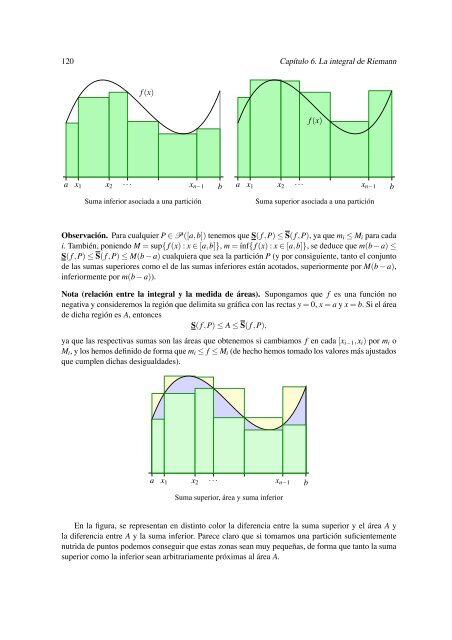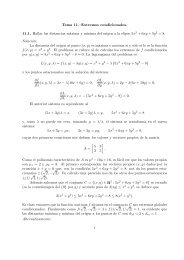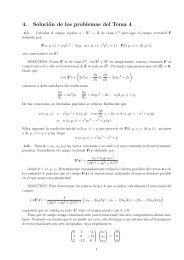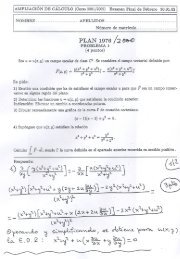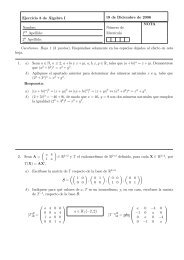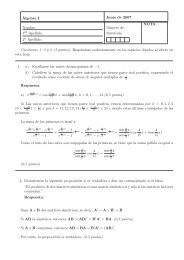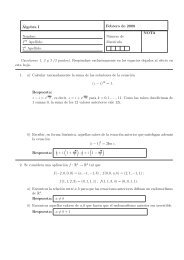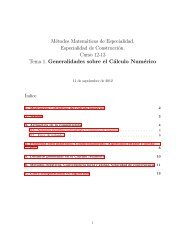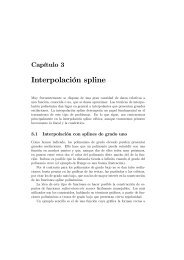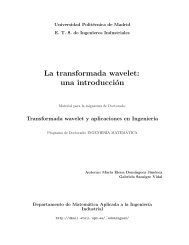La integral de Riemann - dmaii
La integral de Riemann - dmaii
La integral de Riemann - dmaii
You also want an ePaper? Increase the reach of your titles
YUMPU automatically turns print PDFs into web optimized ePapers that Google loves.
120 Capítulo 6. <strong>La</strong> <strong>integral</strong> <strong>de</strong> <strong>Riemann</strong><br />
f (x)<br />
a x1 x2 ... xn−1 b<br />
Suma inferior asociada a una partición<br />
f (x)<br />
a x1 x2 ... xn−1 b<br />
Suma superior asociada a una partición<br />
Observación. Para cualquier P ∈ P([a,b]) tenemos que S( f ,P) ≤ S( f ,P), ya que mi ≤ Mi para cada<br />
i. También, poniendo M = sup{ f (x) : x ∈ [a,b]}, m = ínf{ f (x) : x ∈ [a,b]}, se <strong>de</strong>duce que m(b − a) ≤<br />
S( f ,P) ≤ S( f ,P) ≤ M(b − a) cualquiera que sea la partición P (y por consiguiente, tanto el conjunto<br />
<strong>de</strong> las sumas superiores como el <strong>de</strong> las sumas inferiores están acotados, superiormente por M(b − a),<br />
inferiormente por m(b − a)).<br />
Nota (relación entre la <strong>integral</strong> y la medida <strong>de</strong> áreas). Supongamos que f es una función no<br />
negativa y consi<strong>de</strong>remos la región que <strong>de</strong>limita su gráfica con las rectas y = 0, x = a y x = b. Si el área<br />
<strong>de</strong> dicha región es A, entonces<br />
S( f ,P) ≤ A ≤ S( f ,P),<br />
ya que las respectivas sumas son las áreas que obtenemos si cambiamos f en cada [xi−1,xi) por mi o<br />
Mi, y los hemos <strong>de</strong>finido <strong>de</strong> forma que mi ≤ f ≤ Mi (<strong>de</strong> hecho hemos tomado los valores más ajustados<br />
que cumplen dichas <strong>de</strong>sigualda<strong>de</strong>s).<br />
a x1 x2 ... xn−1 b<br />
Suma superior, área y suma inferior<br />
En la figura, se representan en distinto color la diferencia entre la suma superior y el área A y<br />
la diferencia entre A y la suma inferior. Parece claro que si tomamos una partición suficientemente<br />
nutrida <strong>de</strong> puntos po<strong>de</strong>mos conseguir que estas zonas sean muy pequeñas, <strong>de</strong> forma que tanto la suma<br />
superior como la inferior sean arbitrariamente próximas al área A.


